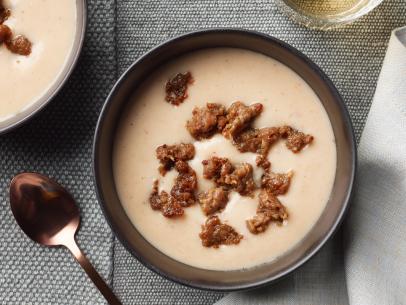
Dal Fry
- Level: Easy
- Total: 40 min
- Active: 30 min
- Yield: 4 servings (4 cups)
-
- Nutritional Analysis
- Per Serving
- Serving Size
- 1 of 4 servings
- Calories
- 291
- Total Fat
- 11 g
- Saturated Fat
- 8 g
- Carbohydrates
- 38 g
- Dietary Fiber
- 7 g
- Sugar
- 4 g
- Protein
- 13 g
- Cholesterol
- 8 mg
- Sodium
- 394 mg
- Level: Easy
- Total: 40 min
- Active: 30 min
- Yield: 4 servings (4 cups)
-
- Nutritional Analysis
- Per Serving
- Serving Size
- 1 of 4 servings
- Calories
- 291
- Total Fat
- 11 g
- Saturated Fat
- 8 g
- Carbohydrates
- 38 g
- Dietary Fiber
- 7 g
- Sugar
- 4 g
- Protein
- 13 g
- Cholesterol
- 8 mg
- Sodium
- 394 mg
Ingredients
Directions
- Drain the soaked lentils and place them in a medium Dutch oven. Add 4 cups water, the turmeric, ginger, slit green chile and 1 teaspoon salt. Bring to a boil over high heat, lower the temperature slightly so it just boils and cook until the lentils are completely soft, about 20 minutes.
- Remove the whole green chile. Use a whisk or a hand beater to churn the dal so the texture is even (in India we use a wooden dal ghutni for this).
- Meanwhile, make the tadka by heating the ghee in a medium skillet over medium heat. Once hot add the cumin seeds and cook until they darken, about 15 seconds. Stir in the bay leaves, crushed red pepper, and asafetida and give it a quick stir. Add the garlic and cook until it sizzles and infuses the ghee, 30 seconds to 1 minute.
- Add the onion and cook until golden, 4 to 7 minutes. Add the tomatoes and 1/2 teaspoon salt and cook until the mixture thickens, 5 to 7 minutes.
- Once the dal is cooked, add the tadka mixture to the dal. The consistency should be that of a cream soup; add more water if it’s too thick or increase the heat and simmer for a few minutes if it’s too thin. Add salt to taste. Serve garnished with cilantro and drizzle with melted butter or ghee, if using, for a richer dish. Serve with lime wedges on the side.
Cook’s Note
Asafetida (also called hing) is a spice with a strong, distinctive odor; a tiny amount adds a lot of flavor to a dish. It’s extremely expensive in its pure form so it’s generally compounded with wheat or rice flour and turmeric. In my view it’s essential for making this dal. While quality varies in commercial brands, I have been impressed with the asafetida from Pure Indian Foods. Incidentally, the spice is thought by some to have anti-flatulence qualities and is added to many of the legume dishes in India.

































